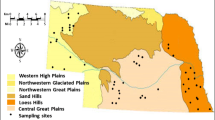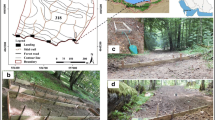Abstract
Many chemical and non-chemical strategies have been applied to control weeds in agricultural and industrial areas. Knowledge regarding the effects of these methods on roadside vegetation is still poor. A 2-year field experiment was performed along a road located near Livorno (Tuscany, central Italy). Eight plots/strips were identified, of which four were subjected to periodical mechanical mowing and the remaining four were treated with a chemical herbicide based on glyphosate (the producer’s recommended rates were used for the selective control of broad-leaved weeds). Our results clearly showed that roadside soil and vegetation are a significant reservoir of anthropogenic activities which have a strong negative effect on several phytosociological, pedochemical and biological parameters. Compared with conventional mechanical mowing, chemical treatment induced (i) a significant increase in organic matter in the upper plot layers (+18 %), and (ii) a marked reduction in weed height throughout the entire period of the experiment. Irrespectively of the kind of treatment, no significance differences were detected in terms of (i) biological quality of soil (the abundance and diversity of arthropod communities did not change), and (ii) plant elemental content (bulk concentrations of analysed trace elements had a good fit within ranges of occurrence in the “reference plant”). The glyphosate partially controlled broad-leaved weeds and this moderate efficacy is dependent upon the season/time of application. In conclusion, the rational and sustainable use of chemical herbicides may be a useful tool for the management of roadside vegetation.

Similar content being viewed by others
References
Abu-Dieyeh M, Watson A (2005) Impact of mowing and weed control on broadleaf weed population dynamics in turf. J Plant Interact 1:239–252
ASAB/ABS (2012) Guidelines for the treatment of animals in behavioral research and teaching. Animal Behav 83:301–309
Aslam J, Khan SA, Khan SH (2013) Heavy metals contamination in roadside soil near different traffic signals in Dubai, United Arab Emirates. J Saudi Chem Soc 17:315–319
Aspetti GP, Boccelli R, Ampollini D, Del Re AAM, Capri E (2010) Assessment of soil-quality index based on microarthropods in corn cultivation in Northern Italy. Ecol Ind 10:129–135
Baboo M, Pasayat M, Samal A, Kujur M, Maharana JK, Patel AK (2013) Effect of four herbicides on soil organic carbon, microbial biomass-C, enzyme activity and microbial populations in agricultural soil. Int J Res Environ Sci Technol 3:100–112
Blasi S, Menta C, Balducci L, Conti F, Petrini E, Piovesan G (2013) Soil microarthropod communities from Mediterranean forest ecosystems in Central Italy under different disturbances. Environ Monit Assess 185:1637–1655
Borggaard OK, Gimsing AL (2008) Fate of glyphosate in soil and the possibility of leaching to ground water and surface waters: a review. Pest Manag Sci 64:441–456
Botta F, Lavison G, Couturier G, Alliot F, Moreau-Guigon E, Fauchon N, Guery B, Chevreuil M, Blanchoud H (2009) Transfer of glyphosate and its degradate AMPA to surface waters through urban sewerage systems. Chemosphere 77:133–139
Braun-Blanquet J (1964) Pflanzen soziologie. 3. Aufl., Wien
Brement JM, Mulvaney CS (1982) Nitrogen-total. In: Methods of soil analysis. Part 2—Chemical and microbiological properties. Madison: Edition ASA SSSA
Busey P (2003) Cultural management of weeds in turfgrass: a review. Crop Sci 43:1899–1911
Cherni AE, Trabelsi D, Chebil S, Barhoumi F, Rodríguez-Llorente ID, Zribi K (2015) Effect of glyphosate on enzymatic activities, Rhizobiaceae and total bacterial communities in an agricultural tunisian soil. Water Air Soil Pollut 226:145–156
Cillieris SS, Bredenkamp GJ (2000) Vegetation of road verges on an urbanisation gradient in Potchefstrrom, South Africa. Landsc Urban Plan 46:217–239
Cuhra M, Traavik T, Bøhn T (2013) Clone- and age-dependent toxicity of a glyphosate commercial formulation and its active ingredient in Daphnia magna. Ecotoxicology 22:251–262
Dewar RC, Porté A (2008) Statistical mechanics unifies different ecological patterns. J Theor Biol 251:389–403
Donald WW (1990) Management and control of Canada thistle (Cirsium arvense). Rev Weed Sci 5:193–250
Duce RA, Hoffman GL, Zoller WH (1975) Atmospheric trace metals at remote northern and southern hemisphere sites: pollution or natural. Science 187:59–61
Duke SO, Powles SB (2008) Glyphosate: A once in a century herbicide. Pest Manag Sci 64:319–325
El-Kholy RMA, Abouamer WL, Ayoub MM (2013) Efficacy of some herbicides for controlling broad-leaved weeds in wheat fields. J Appl Sci Res 9:945–951
Forman RTT, Alexander LE (1998) Roads and their major ecological effects. Ann Rev Ecol Syst 29:207–231
Foster L (1989) The biology and non-chemical control of dock species Rumex obtusifolius and R. crispus. Biol Agric Hortic 6:11–25
Fry J, Huang B (2004) Applied turfgrass science and physiology. Wiley, New Jersey, p 310
Fujiwara F, Rebagliati RJ, Marrero J, Gomez D, Smichowski P (2011) Antimony as a traffic-related element in size-fractioned road dust samples collected in Buenos Aires. Microchem J 97:62–67
Galli L, Capirro M, Menta C, Rellini I (2014) Is the QBS-ar index a good tool to detect the soil quality in Mediterranean areas? A cork tree Quercus suber L. (Fagaceae) wood as a case of study. Italian J Zool 81:126–135
Giesy JP, Dobson S, Solomon KR (2000) Ecotoxicological risk assessment for Roundup® herbicide. Rev Environ Contam Toxicol 167:35–120
Giliba RA, Boon EK, Kayombo CJ, Musamba EB, Kashindye AM, Shayo PF (2011) Species composition, richness and diversity in Miombo woodland of Bereku Forest Reserve, Tanzania. J Biodivers 2:1–7
Guéguen F, Stille P, Geagea ML, Boutin R (2012) Atmospheric pollution in an urban environment by tree bark biomonitoring—Part I: trace element analysis. Chemosphere 86:1013–1019
Helmreich B, Hilliges R, Schriewer A, Horn H (2010) Runoff pollutants of a highly trafficked urban road—correlation analysis and seasonal influences. Chemosphere 80:991–997
Huguier P, Manier N, Owojori OJ, Bauda P, Pandard P, Römbke J (2015) The use of soil mites in ecotoxicology: a review. Ecotoxicology 24:1–18
Lorenzini G, Grassi C, Nali C, Petiti A, Loppi S, Tognotti L (2006) Leaves of Pittosporum tobira as indicators of airborne trace element and PM10 distribution in Central Italy. Atmos Environ 40:4025–4036
Macfadyen A (1961) Improved funnel-type extractors for soil arthropods. J Animal Ecol 30:171–184
Mangani G, Berloni A, Bellucci F, Tatano F, Maione M (2005) Evaluation of the pollutant content in road runoff first flush waters. Water Air Soil Pollut 160:213–228
Markert B (1992) Establishing the “reference plant” for inorganic characterization of different plant species by chemical fingerprint. Water Air Soil Pollut 64:533–538
Mc Lean EO (1982) Soil pH and lime requirement. In: Methods of soil analysis. Part 2—Chemical and microbiological properties. Madison: Edition ASA SSSA
Modrzewska B, Wyszkowski M (2014) Trace metals content in soils along the state road 51 (northeastern Poland). Environ Monit Assess 186:2589–2597
Nali C, Ferretti M, Pellegrini M, Lorenzini G (2001) Monitoring and biomonitoring of surface ozone in Florence, Italy. Environ Monit Assess 69:159–174
Nelson DW, Sommers LE (1982) Total carbon, organic carbon, and organic matter. In: Methods of soil analysis. Part 2—Chemical and microbiological properties. Madison: Edition ASA SSSA
Olsen SR, Sommers LE (1982) Phosphorus. In: Methods of soil analysis. Part 2—Chemical and microbiological properties. Madison: Edition ASA SSSA
Palacios MA, Gòmez M, Moldovan M, Gòmez B (2000) Assessment of environmental contamination risk by Pt, Rh and Pd from automobile catalyst. Microchem J 67:105–113
Paoletti MG, Favretto MR, Stinner BR, Purrington FF, Bater JE (1991) Invertebrate as bioindicators of soil use. Agric Ecosyst Environ 34:341–362
Paoli L, Corsini A, Bigagli V, Vannini J, Bruscoli C, Loppi S (2012) Long-term biological monitoring of environmental quality around a solid waste landfill assessed with lichens. Environ Pollut 161:70–75
Parisi V, Menta C, Gardi C et al (2005) Microarthropod communities as a tool to assess soil quality and biodiversity: a new approach in Italy. Agric Ecosyst Environ 105:323–333
Pellegrini E, Cioni PL, Francini A et al (2012) Volatile emission patterns in poplar clones varying in response to ozone. J Chem Ecol 38:924–932
Pellegrini E, Lorenzini G, Loppi S, Nali C (2014) Evaluation of the suitability of Tillandsia usneoides (L.) L. as biomonitor of airborne elements in an urban area of Italy, Mediterranean basin. Atmos Pollut Res 5:226–235
Pierson WR, Brachaczek W (1974) Airborne particulate debris from rubber tires. Rubber Chem Technol 47:1275–1299
Sebiomo A, Ogundero VW, Bankole SA (2011) Effect of four herbicides on microbial population, soil organic matter and dehydrogenase activity. Afr J Biotechnol 10:770–778
Simpson EH (1949) Measurement of diversity. Nature 163:688
Spencer HJ, Port GR (1988) Effects of roadside on plants and insects, II. Soil conditions. J Appl Ecol 25:709–715
Sternbeck J, Sjodin A, Andreasson K (2002) Metal emissions from road traffic and the influence of resuspension—results from two tunnel studies. Atmos Environ 36:4735–4744
Strauss SY, Agrawal AA (1999) The ecology and evolution of plant tolerance to herbivory. Trends Ecol Evol 14:179–185
Tang T, Boënne W, Desmet N, Seuntjens P, Bronders J, van Griensven A (2015) Quantification and characterization of glyphosate use and loss in a residential area. Sci Total Environ 517:207–214
Taylor SR, McLennan SM (1985) The continental crust: its composition and evolution. Blackwell, Oxford
Thorpe A, Harrison RM (2008) Sources and properties of non-exhaust particulate matter from road traffic: a review. Science Total Environment 400:270–282
Van Stempvoort DR, Roy JW, Brown SJ, Bickerton G (2014) Residues of the herbicide glyphosate in riparian groundwater in urban catchments. Chemosphere 95:455–463
Werkenthin M, Kluge B, Wessoleck G (2014) Metals in European roadside soils and soil solution: a review. Environ Pollut 189:98–110
Wilcox JC (1947) Determination of electrical conductivity of soil solution. Soil Sci 63:107–118
Wu Y-P, Zhang Y, Bi Y-M, Sun Z-J (2015) Biodiversity in saline and non-saline soils along the Bohai sea Coast, China. Pedosphere 25:307–315
Zechmeister HG, Hoehenwallner D, Riss A et al (2005) Estimation of element deposition derived from road traffic sources by using mosses. Environ Pollut 138:238–249
Zhou C-F, Wang Y-J, Yu Y-C, Sun R-J, Zhu X-D, Zhang H-L, Zhou D-M (2012) Does glyphosate impact on Cu uptake by, and toxicity to, the earthworm Eisenia fetida? Ecotoxicology 21:2297–2305
Acknowledgments
We are grateful to several people from the University of Pisa who helped us during the fieldwork and lab activities. Special thanks are due to Paola Belloni, Alessandra Campanella, Barbara Conti, Marco Ginanni, Roberto Macchioni, Giovanni Melai, Alessandro Pannocchia, Romina Papini, Andrea Parrini, Rosalba Risaliti. Mirco Branchetti (Comune di Livorno) also provided a fundamental logistical contribution.
Author information
Authors and Affiliations
Corresponding author
Ethics declarations
Source of funds
The project was partially funded by ADES, Ambiente, Decoro e Salute, Rome, grant 870 (23 December 2010). The authors’ work was independent of the funders in terms of (i) the study design; (ii) the collection, analysis and interpretation of data; (iii) the writing of the report; and (iv) the decision to submit the paper for publication.
Disclosure of potential conflict of interest
The authors declare that they have no conflicts of interest.
Ethical approval
“All applicable international, national, and/or institutional guidelines for the care and use of animals were followed.” This research adheres to the ASAB/ABS Guidelines for the Use of Animals in Research (2012). All treatments of the experimental animals (acari and collembola) were in compliance with Italian regulations on the protection of animals used for experimental and other scientific purposes (D.M. 116192). All experimental procedures also followed the animal care guidelines of the University of Pisa Ethical Committee. No particular permits were needed from the Italian government for experiments involving acari and collembola.
Rights and permissions
About this article
Cite this article
Pellegrini, E., Falcone, L., Loppi, S. et al. Impact of mechanical mowing and chemical treatment on phytosociological, pedochemical and biological parameters in roadside soils and vegetation. Ecotoxicology 25, 279–290 (2016). https://doi.org/10.1007/s10646-015-1586-6
Accepted:
Published:
Issue Date:
DOI: https://doi.org/10.1007/s10646-015-1586-6




